Sun Odyssey 415: Twelve-metre cruiser sets new standards - also in terms of price
Michael Good
· 25.09.2025
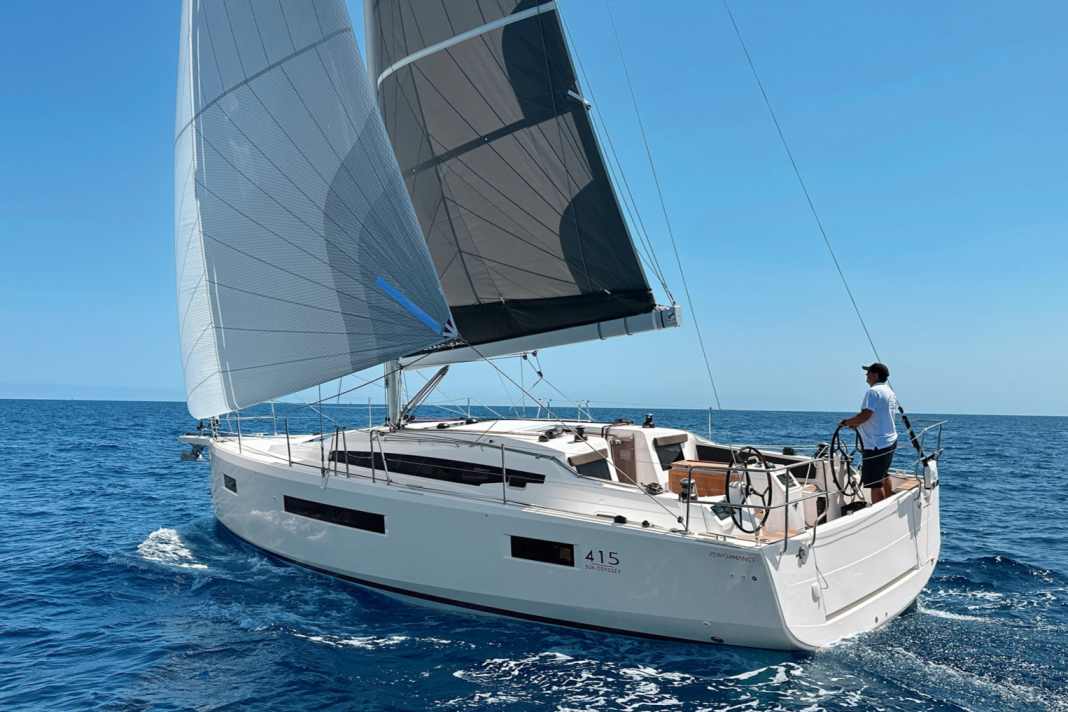





For years, prices for new sailing yachts have generally only gone in one direction: steeply upwards. Particularly during and in the aftermath of the coronavirus pandemic, significant price increases have almost become the norm in the industry - driven by supply bottlenecks, increased raw material costs and yet still high demand.
More from the shipyard:
- Sun Odyssey 319: Attractive, versatile and sought-after
- Sun Odyssey 380: The all-rounder from France put to the test
- Sun Odyssey 410: Cruising yacht from France
- Jeanneau Yachts 55: Is this the cruising yacht of the future?
- Sun Fast 3300: The radical performance boat from Jeanneau
- Jeanneau Sun Fast 30 OD on test: New regatta one-design class without compromises
This makes the change of course that Jeanneau is now apparently taking all the more surprising. With the new Sun Odyssey 415, the yacht builders in Les Herbiers on the French west coast are not only presenting a fresh model in their popular touring range, but are also lowering the price - significantly. The 415 is not a completely newly developed boat, but rather a complete redesign of the predecessor model 410 from 2018.
Prices of the Sun Odyssey 415
With concrete figures: The new Sun Odyssey 415 is now being presented at a base price of 260,610 euros gross (including 19 per cent tax) and will be unveiled as a world premiere at the Yachting Festival in Cannes in September. This introductory price is initially valid for orders placed until the end of this year.
- Base price ex shipyard: 260.610 €
- Standard equipment included: Engine, sails, sheets, railing, navigation lights, battery, compass, sails, cushions, galley/ cooker, bilge pump, toilet, sailcloth (lazybags), electric cooler, holding tank with suction.
- For an extra charge: Anchor with chain €1,275, fender/mooring €665, antifouling €4,020, clear sailing handover €6,270
- Price ready to sail: 272.840 €
- Guarantee/against osmosis: 3/3 years
- Surcharge for comfort equipment: Line-adjustable anchor points incl.; Traveller not available; Electric windlass € 2,750; Tube kicker incl.; Backstay tensioner (hydr.) € 4,485; Jumping cleats incl.; Sprayhood € 2,320; Teak in cockpit incl.; VHF radio electronics package; Log and echo sounder electronics package; Wind gauge electronics package; Autopilot electronics package; Electronics package € 10.065 €; Battery charger 535 €; Shore power connection with RCD 520 €; 230-volt socket (one) 3,690 €; 12-volt socket in the sat nav incl.; Heating 6,340 €; Pressurised water system incl.; Hot water boiler incl.; Shower WC room incl.; Cockpit shower incl.
- Comfort price: 303.545 €
- Included in the price: Cockpit table (plastic), bathing platform with bathing ladder, bowsprit, 3D mooring points
Status 2025, how the prices shown are defined, read here!
This will be followed by a regular base price of 276,675 euros from 2026. For comparison: the predecessor model Sun Odyssey 410 was last on offer for a gross price of 289,290 euros. This means a price reduction on the new boat of around 12,615 euros or just under five per cent. More remarkable than the bare figures, however, is the fact that industry giant Jeanneau, of all companies, is now daring to change course and, after a long time, is once again putting the brakes on prices.
Will price brakes become a new trend in the industry?
What is behind this strategy? Just a move by Jeanneau to grab market share - or perhaps the start of a major course correction in the industry as a whole? And how will the other manufacturers react to this signal? A look at the price structure in this extremely homogeneous class with a hull length of twelve metres shows the Jeanneau Sun Odyssey 415 to be the cheapest boat, even if the price differences within the competition from the large product series remain manageable and comparable.
Measurement results of the Sun Odyssey 415
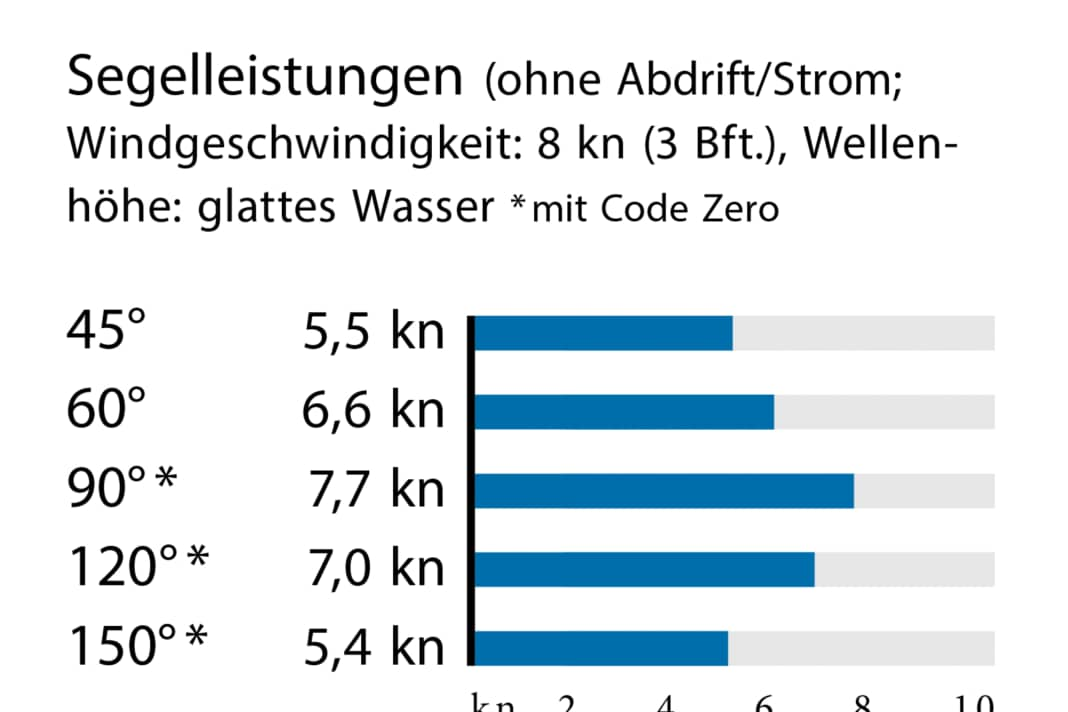




Jeanneau Product Manager Jérôme Dufour explains the ambitious downward price adjustment: "We have deliberately removed as many cost-intensive and unnecessary components as possible from the previous model. In return, we were able to improve the quality and upgrade the features." In the case of the redesign from the Sun Odyssey 410 to the 415, this strategy was primarily implemented as part of a complete redesign of the saloon.
Now more straightforward and conventional below deck
The shipyard has jettisoned the nested and therefore elaborate arrangement of the previous model with the large U-shaped galley, the too small seating area on the starboard side and, above all, the unusual chaise longue built into the centre of the saloon. The new layout of the 415 is now more straightforward, less pretentious and, above all, much more conventional. And thanks to the consistent omission of many obsolete built-in elements, the impression of space is more open and also feels much more spacious. Jeanneau has done a great job overall.
The L-shaped galley is now installed at the rear of the saloon and scores highly in terms of functionality with its large work surfaces and many well thought-out storage compartments. The seating area on the port side has become much larger and can accommodate up to six people. The table can be easily lowered so that the entire area can be used as an additional double berth. And on the starboard side, there is another table surrounded by two comfortable armchairs. This area can also be used as a navigation table - a good and practical solution.
The cabins forward and aft, on the other hand, remain the same size and essentially the same layout. There are still expansion options in the bow, where a second wet room can be installed on request. Here too, the shipyard can benefit from the streamlined processes in series production and installs the same built-in module twice with plenty of space and a separable shower area. Incidentally, a second wet room in the foredeck is also one of the standard fitting options on competitor yachts, but in most cases it is smaller and without a separable shower.
Aft, the double cabin on the port side can also be used as a large storage space that can be accessed from the inside. In this two-cabin version, only the berth cushions are essentially omitted and the storage compartments are arranged differently. And the space is also accessible from the outside directly from the cockpit.
Walkaround cockpit even at twelve metres
Jeanneau has made few changes to the hull. However, the stern has been redesigned in collaboration with the designers at Marc Lombard Yacht Design. The flanks of the hull are now concave at the rear, giving it a modern and sporty look. More importantly, however, the width of the stern at deck level has increased by 14 centimetres while the waterline remains unchanged. Jeanneau's aim here is to ensure that the double-guided backstay can be attached further out and that there is a little more space for the helmsman.
This is because the helmsman sits uncomfortably on the very small area behind the steering wheel and does not know where to put his legs. The best position on the wheel is therefore standing up, although this is tiring in the long run. This is a compromise that is entirely due to the innovative walkaround cockpit, which Jeanneau introduced eight years ago as a revolutionary new feature with the Sun Odyssey 440 and has since implemented it consistently on all boats in the series.
The recessed running decks are not only advantageous for safe, barrier-free passageways around the helm stations, but also for perfect handling. The helmsman can work on the winches both upwind and downwind without cramping and while standing, and at the same time retains control of the steering. In addition, the mainsail and genoa sheets are led back on both sides directly in front of the helm stations. This makes it easy for small crews and especially single-handed sailors to manoeuvre, despite the overlapping genoa, which is part of the standard equipment. The self-tacking jib - usually defined as standard on competitor boats - is only optional on Jeanneau.
Light, lively and balanced under sail
The test in the south of France takes place in a light breeze of just eight knots. This is enough to accelerate the comparatively lightly built Sun Odyssey 415 quickly to a good speed of 5.5 knots when sailing close to the wind. The turning angle is 90 degrees, which is within the expected range. The sailing characteristics become more dynamic with Code Zero, with which the Frenchwoman comes close to the true wind speed. However, the very good performance values are undoubtedly due in part to the performance package with which the test boat is equipped. The powerful package includes a higher mast, more sail area, high-quality laminate sails and better trimming options. It is remarkable how spiritedly the boat reacts to rudder commands with its two widely spaced rudder blades. It turns easily and lively and can also be steered precisely downwind using the well-balanced steering. Light pressure makes it easy for the helmsman.
With the new Sun Odyssey 415 model, Jeanneau proves that it doesn't always take a radical new development to breathe new life into a model series. By making targeted improvements to details, the shipyard can optimise production costs and keep the price attractive - without compromising on quality and equipment. This makes customers happy, while the competition has to think twice.
YACHT review of the Sun Odyssey 415
With the complete overhaul of its twelve-metre cruiser and ambitious pricing, Jeanneau is setting new standards for a new generation of Sun Odyssey. The concept is honest and straightforward, and the boat also has sailing potential.
Design and concept
Slim torso in comparison
Wide range of interior fittings
Robust but lightweight construction
Attractive pricing
Sailing performance and trim
One-handed suitability
Good trimming facilities
Genoa in standard
Little space for helmsman
Living and finishing quality
Complete remodelling in the salon
Two wet cells with showers
Easily usable storage spaces
Large pantry with plenty of space
Equipment and technology
High-quality deck equipment
Many openings for ventilation
Unclean cabling
Bathing flap high above water
The Sun Odyssey 415 in detail
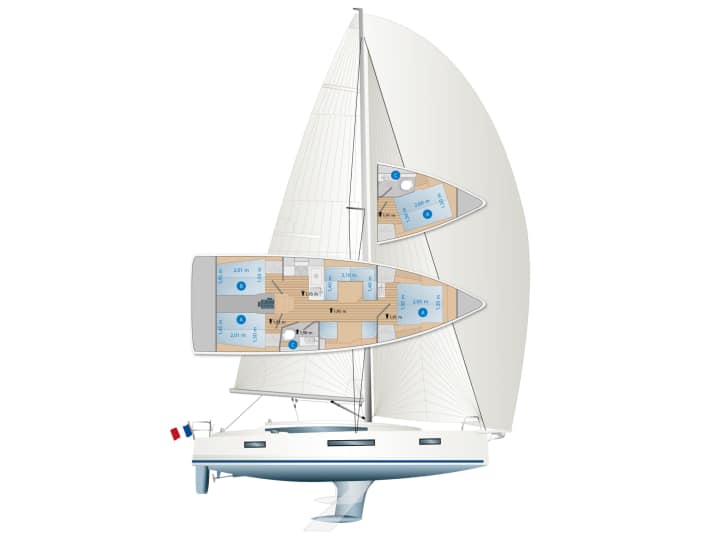
Technical data of the Sun Odyssey 415
- Designer: Marc Lombard Yacht Design
- CE design category: A
- Torso length: 11,99 m
- Total length: 12,95 m
- Waterline length: 11,47 m
- Width: 3,99 m
- Draught/alternative: 2,25/1,60 m
- Draught Swivelling keel: 1,37-2,97 m
- Mast height above WL: 17,70 m
- Theor. torso speed: 8.2 kn
- Weight: 7,7 t
- Ballast/proportion: 2,0 t/26 %
- Mainsail: 43,6 m²
- Furling genoa (110 %): 36,8 m²
- machine (Yanmar): 33 kW/45 hp
- Fuel tank PVC: 200 l
- Fresh water tanks PVC: 200 + 330 l
- Holding tank PVC: 2 x 80 litres
Hull and deck construction
- Hull: GRP full laminate with polyester resin.
- Deck: Sandwich laminate built with vacuum injection.
Sailing
A single set of Dacron sails is included in the basic price.
Motorisation
Four-cylinder built-in diesel from Yanmar (4JH45) with 45 hp output. Shaft drive with three-blade fixed propeller. An optional electric pod drive is in preparation.
Energy supply on board
As standard: 2 x 95 AH (AGM) service, 1 x 95 AH (AGM) starter. Additional AGM batteries or lithium batteries optional.
Shipyard
Chantiers Jeanneau; 85500 Les Herbiers (France); www.jeanneau.de
Distribution
Dealer network
Competition from the Sun Odyssey 415
The popular class of cruisers around twelve metres in length is quite homogeneous.
Bavaria C42

Modern and very voluminous tourer from Germany with a multitude of imaginative details. The design comes from Maurizio Cossutti. Available with two or three cabins. You can read the test here.
Beneteau Oceanis 40.1
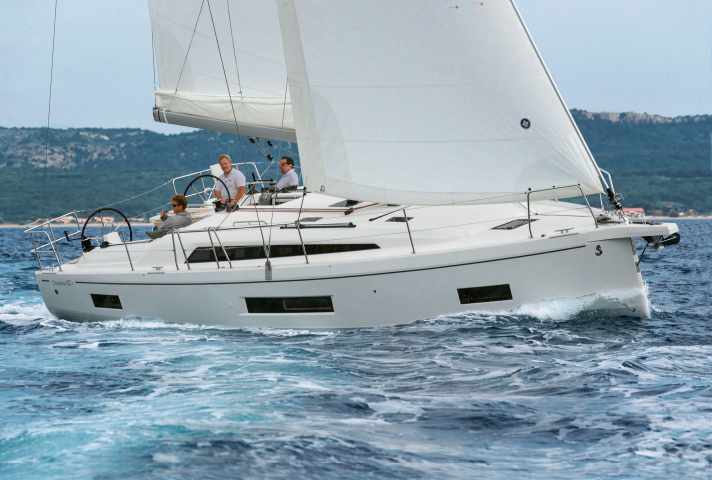
With her radical, independent hull lines by Marc Lombard Yacht Design, the Frenchwoman polarises in class comparison. In the test, the Oceanis scored with good, balanced sailing characteristics. Read the test here.
Dufour 41
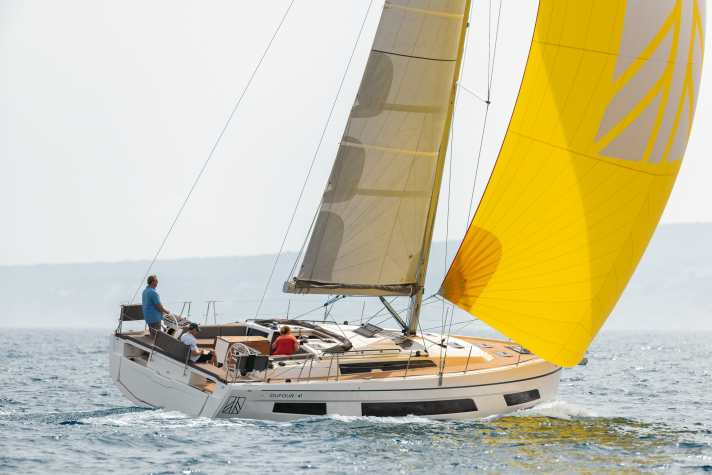
It has the widest beam in its class. Dufour utilises the volume for a high degree of configuration variance with up to four cabins for chartering. The galley is built into the side of the saloon as a long row. Read the test here.
Hanse 410

Honest, straightforward boat concept from Greifwald. Handling with the self-tacking jib is simple and suitable for single-handed sailing. All sheets and halyards are led back to the helm stations without exception. Read the test here.
ADVERTISEMENT

Insure your Sun Odyssey 415 from 1,395.77 euros per year or 116.31 euros per month* - liability and comprehensive cover. Many options available: also protect extended fishing or diving equipment. Simply calculate online and take out cover: yachting24.de
* Offer from Yachting24 valid for a sum insured of 261,000 euros (with current value cover), excess of 1500 euros, liability cover of 8 million euros.

